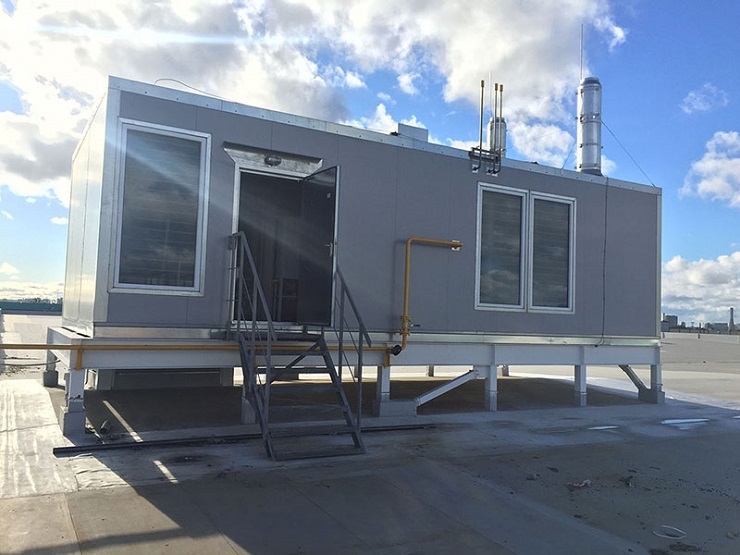If you are not an ardent adherent of the loft or techno style, then the appearance of the heating unit is unlikely to be a pleasure. After all, it is produced focusing on the mass consumer, and not on your personal taste. Naturally, you will think about how to hide the gas boiler in the kitchen so that it fits perfectly into the interior picture.
However, when it comes to camouflaging gas equipment, things are not so simple. In addition to finding the most suitable design option, you also need to take into account the standards. Compliance with the rules for normal operation guarantees safety when using a gas hot water supplier.
We will tell you how best to hide the presence of far from the most attractive object in the kitchen, taking into account the requirements of gas services and fire authorities. The article presented by us sets out in detail the norms for the location of gas equipment. Here you will find interesting and practical solutions for the design of kitchens with gas boilers.
The content of the article:
-
Room and equipment regulations
- Requirements for the organization of gas supply
- Rules for arranging kitchen space
- Features of the selection of the boiler
- Fire prevention standards
- The specifics of the location of the gas unit
-
Design Achievements in Disguise
- How to hide a wall-mounted boiler?
- How do I hide the floor equipment?
- What to do with communications and chimney?
- Conclusions and useful video on the topic
Room and equipment regulations
Before you start developing a unique design for arranging a kitchen with a gas boiler or choosing a ready-made solutions for its registration, you should find out how the room should be equipped for the operation of gas equipment.
It is important to decide in advance on the option of the boiler, which can be used in a private or multi-storey building. Find out what you need to do to ensure complete security. Only then will it be possible to select a camouflage method that does not violate regulatory requirements.
Image gallery
Photo from
Boilers that process blue fuel for heating the coolant and preparing hot water, the most demanded version of the equipment
According to the method of installation, boilers are divided into floor-standing and wall-mounted models. Both those and others are single and double-circuit
In the kitchens of apartments in multi-storey buildings, gas water heaters are most often installed - flow-through appliances used to heat hot water
Those wishing to hide gas equipment in the kitchen must comply with all requirements to ensure the normal and safe operation of the appliance
Heating equipment in the kitchen of a private house
Wall-mounted version of gas equipment
Gas water heater in the kitchen in a high-rise building
Compliant camouflage
Requirements for the organization of gas supply
The regulations state that:
- The installation of a boiler that processes gas for the preparation of heat carrier or sanitary water is allowed only in buildings with up to five storeys inclusive.
- In a kitchen belonging to a separate apartment in a high-rise building, boilers with a capacity of up to 35 kW are installed. These are mainly wall-mounted flow-through heat generators (columns) that supply sanitary hot water.
- In the kitchens of private houses, if it is impossible to arrange a separate boiler room, it is allowed to install a boiler with a capacity of more than 35 kW, subject to all the safety measures and measures regulated by the standards.
In private houses with autonomous communications, it is recommended to organize separate boilers from the kitchen with a pair of boilers. It is best that the preparation of the coolant is carried out floor boiler. But it is advisable to entrust the heating of water for sanitary and hygienic purposes gas water heater or a DHW cylinder (boiler).
Image gallery
Photo from
For installation in apartments, summer cottages and small private houses, boilers with a capacity of up to 35 kW are installed. Their capacity is sufficient for the preparation of hot water for hygienic purposes.
The organization of the heating network in a private house is carried out using more powerful equipment. For heat supply devices at objects with an area of more than 150 m, floor-standing gas boilers are purchased
A double-circuit boiler, which can be both wall-mounted and floor-standing, will cope with the preparation of both the coolant and hot water. Condensation models are most effective
Autonomous communications of a private house are usually arranged on the basis of a pair of boilers. Floor-standing is used to heat the coolant, wall-mounted - for hot water
Low-power boiler in a standard kitchen
Floor standing boiler for a private house
Double-circuit condensing boiler
Tandem floor and wall boilers
It should be remembered that the total heating capacity of the two involved boilers located in one cubic meter must not exceed the technical limit of 100 kW. Note that the installation of gas boilers is allowed in corridors if they have transoms for ventilation. It is no longer possible to install any gas boilers in bathrooms.
Rules for arranging kitchen space
Installation and subsequent operation of gas water heating equipment is allowed in kitchens with a ceiling height not lower than the limit of 2.0 m, indicated in building codes. If the height of the room is reduced due to the installation of a suspended / stretch ceiling, it is dismantled or switched to an electric type of hot water preparation.
If, in addition to the gas boiler, there is also a gas stove in the kitchen, the smallest ceiling height should be 2.2 m. there must be a distance from the floor plane to the ceiling in the boiler installation area, if the ceiling in the kitchen is built with a slope.
Image gallery
Photo from
The height of the ceilings in a room with gas boilers installed in it must be at least 2.2 m. pipes are laid with the ceiling or a suspended ceiling structure is arranged, then the total height is counted from their bottom edge
If the gas boiler is installed in a room with sloping ceilings, then it must be located at the point at which the height to the ceiling is 2.2 m or more.
The height to the upper structure must be at least 2.2 m if the gas boiler is placed under the stairs
If, due to a suspended / suspended ceiling structure, the ceiling height is reduced, either the gas boiler or the ceiling structure will have to be abandoned
Room with gas boilers
Gas water heater in the attic
Floor standing gas unit under the stairs
Installing a false ceiling
Installation of a gas boiler can be carried out in rooms:
- a volume of 7.5 m³, if only one unit is to be operated;
- volume of 13.5 m³, if two heat generators are involved in the preparation of the heat carrier and heating the water.
The cubic capacity of kitchens equipped with both boilers and gas stoves is calculated as the sum of 6.3 m³ plus 8, 12 or 15 m³, depending on the number of burners (2, 3 or 4 pieces).
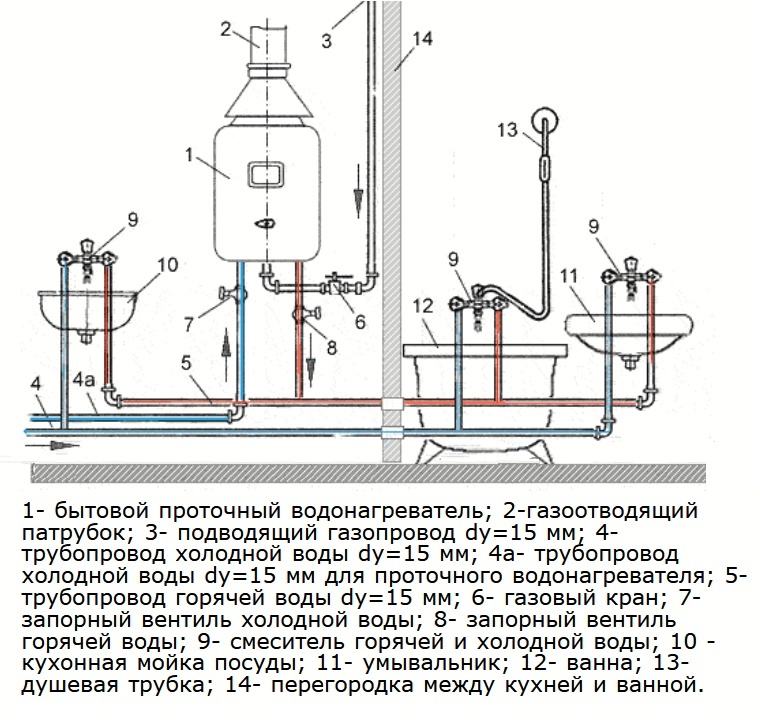
Wall-mounted gas water heaters are hung on hooks pre-installed in the wall. There should be free space on the sides and front of the device, which is required for regular inspection, scheduled and unscheduled maintenance.
The room for the location of gas equipment of any type must have its own source of natural light, i.e. window. The window must have a freely opening window. It is necessary for ventilation with natural induction of air mass movement.
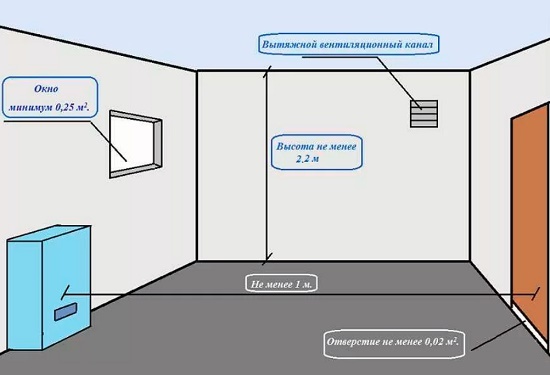
The room in which the gas water heater is installed must have its own source of natural light, equipped with a transom. There should be a door separating the kitchen / boiler room from the living area, and a ventilation gap or grate in its canvas
There must certainly be a door that limits the kitchen space. However, it should not impede the movement of the air flow.
Therefore, in the lower part of the door leaf, it is necessary to provide a ventilation grill or leave a gap between the door leaf and the floor. The total area of the ventilation gap is not less than 0.2 m².
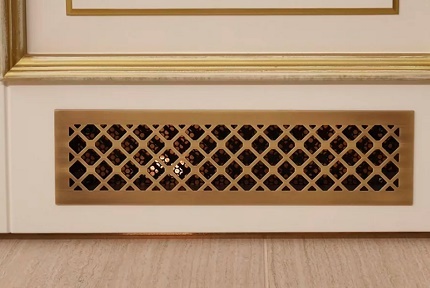
If there is no ventilation gap between the floor plane and the door leaf, a ventilation grill must be provided.
Kitchens with a gas water heater, especially those equipped with atmospheric gas burners, can only have natural ventilation. Forced options with mechanical stimulation and heated air admixture are permissible only in the northern regions.
Features of the selection of the boiler
For installation in the kitchen, individual heat generators are suitable - factory-made water heating units. Both flow-through wall-mounted models are applicable, and floor-standing models paired with boilers.
Automated equipment should be purchased that can function without constant maintenance by the operator / owner.
In the arrangement of apartment buildings, the following water heating units can be used:
- turbocharged, i.e. equipped with a sealed (closed) blue fuel processing chamber;
- capable of heating the processed medium up to 95º;
- working under a pressure of 1 MPa;
- equipped with safety automation.
Safety automation is needed to interrupt the gas supply to the burner in the event of a threatening situation. Among the threats are a malfunction of the protection circuits, a drop in the pressure of the heated water or coolant, the extinguishing of the flame, and malfunctions in the smoke exhaust system.
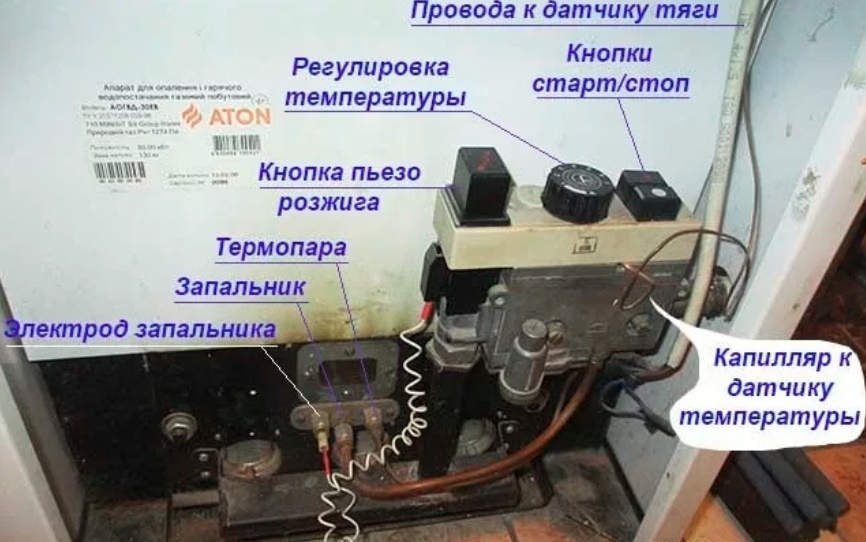
The automatics of the gas apparatus will turn off the gas supply to the burner in the event of a pressure drop in the gas or water supply mains, the device will stop working if the flame goes out, etc. Access to the control buttons of the security system must be always free
In the same way, the automatic device will stop the operation of the boiler if the heated medium reaches the temperature set by the owner or the maximum permissible temperature.
In the kitchens of apartment buildings in our country, heat generators with an atmospheric (open) combustion chamber are traditionally installed. They heat water for owners of apartments in the old housing stock, in which centralized hot water supply was not previously provided.
Fire prevention standards
Before deciding how and what is the best way to close the gas boiler installed in the kitchen, we will analyze the rules for excluding accidental ignition of adjacent or adjacent surfaces and structures.
To prevent and prevent danger, you need to:
- Provide an indent of 2 cm from the walls of the wall-hung boiler to all adjacent surfaces around the perimeter.
- Space from the floor-standing boiler and the DHW cylinder to the surface by 10 cm.
- Protect building walls made of combustible material with plaster or cladding made of non-combustible / hardly combustible types of finishes. In this case, there must be at least 3 cm between the boiler and the wall.
When using tiles in wall decoration, it is allowed to reduce the distance from the walls when placing floor equipment. The gas water heater can be hung close to the tiled wall.
Image gallery
Photo from
Direct contact of gas equipment with flammable and low-flammable materials is strictly prohibited. This must be taken into account when choosing a masking option for a gas unit.
The body of the gas boiler must be continuously "flushed" by air currents. Therefore, it is necessary to leave indents around the apparatus located in a cabinet or niche on all sides.
To form continuous convective air flows, you need to leave a gap at the bottom of the cabinet or install a ventilation grill
If a ready-made furniture module is chosen as a camouflage structure for a gas boiler, its back wall must be removed completely or a hole must be cut out, retreating 7-10 cm along the perimeter
Adjacent wall insulation
Ventilation slots for cooling the case
Ventilation gap at the bottom of the door
Modernization of the furniture module
The function of insulating flammable walls will be successfully performed by roofing sheet on an asbestos sheet with a thickness of at least 3 mm. A similar tandem of tin with asbestos is laid on the floor before installing the floor model. The protective trim should be at least 10 cm larger than the outline of the equipment to be insulated.
All of the listed types of gaps and indents are necessary for the continuous cooling of water heating equipment.
The specifics of the location of the gas unit
Gas heating equipment is located according to the project, which takes into account the type of wiring, the position of the expansion tank and circulation pump. If a wall-mounted appliance, for example, only deals with the preparation of hot water for hygienic use, then put it as close as possible to the draw-off point.
According to regulatory requirements:
- The distance between the column and the kitchen sink can be at least 30 cm.
- The distance between the wall-mounted water heater and the gas hob must be at least 10 cm.
- The distance between the floor-standing heat generator and the refrigerator is specified by the boiler manufacturer. Usually at least 30 cm is indicated. The same size is acceptable for other household electrical appliances.
- The distance from the upper edge of the parapet boiler to the ceiling is at least 80 cm.
- The distance to the outlet required to power volatile systems of gas boilers must be at least 100 cm.
The most important rule that must be observed when installing any type of boiler is to ensure unimpeded access both directly to the unit itself and to the most important components that require regular inspection and service.
Image gallery
Photo from
A valve used to shut off the water supply and a gas valve to shut off the fuel supply must be installed at the inlet of the communications to the boiler. Any kind of disguise is obliged to provide unhindered access to them.
There must be at least 30 cm between the gas atmosphere equipment and the kitchen sink so that there is no possibility of accidental extinguishing of the open burner flame
The hot water supply route to the mixer must be at least 1 m long in order to create conditions for normal operation and correct response of the automation to the state of the system
Cold water should be supplied to the mixer and to the gas water heater through separate, unconnected branches
Location of valve and gas cock
Violations in the location of the gas column
Distance between mixer and gas column
Plumbing connection
It is strictly forbidden to lay pipes, through which blue fuel is transported to devices, in grooves or to close it with non-separable boxes. It is allowed to use camouflage constructions with swing or sliding doors, roller shutters, blinds.
Design Achievements in Disguise
In all cases and variants of masking, it is necessary to observe the technological indents and provide full ventilation of the boiler. This means that those who want to hide the heating equipment need to think over the options for the formation of convective flows that cool the body.
Standard cabinet furniture for installation in the kitchen is usually not designed for the fact that one of its cabinets will hide a floor or wall model of the boiler. True, there are headsets with a module designed just for this task. However, we are interested in other cases.
Let's see if it is possible to ideally hide a gas boiler in a homemade kitchen cabinet, and consider the best options that suggest how to do this work better and more correctly.
How to hide a wall-mounted boiler?
What if you need to match a kitchen cabinet that is not designed to camouflage the boiler? The simplest answer involves disassembling it with cutting holes at the bottom for connecting communications, at the top for removing the chimney. However, these activities are usually not enough.
Image gallery
Photo from
If the installation of a gas water heater is not provided for by the manufacturer of the furniture set, you can build it yourself
One of the practical options for masking will be the installation of a door from an extra module of a furniture set on the frame.
The self-made frame will serve as the basis for attaching blinds or roller shutters
Instead of a door from a cabinet, blinds or other similar solutions, you can put a homemade sash with a mesh cloth
Column frame construction
Installation on the frame of the furniture door
Assembling the base for the blinds
Fixing a homemade mesh door
Before modernizing a kitchen module, it is worth deciding whether it is generally suitable for locating a gas heating or water heating unit inside itself. To do this, you should study and in fact measure the overall dimensions.
Between all the walls of the kitchen cabinet planned for remodeling and wall gas appliance should be at least 2 cm. If the unit is to be hung on hooks close to a tiled or plastered wall, the rear panel of the cabinet will need to be removed.
The best solution would be a frame made specifically for the gas apparatus, taking into account the necessary technological clearances and dimensions of the equipment. It is better to make this base metal welded, although it is easier and more affordable for a home craftsman to work with lumber.
Image gallery
Photo from
The best solution to camouflage a gas water heater is a cabinet with lattice doors
Convenient to use two-level doors with lattice doors. They allow you to open only the area you need for inspection.
The lattice door will provide continuous ventilation flows. As a result, the body will not overheat, and the automation will turn off the boiler for no real reason.
The use of a lattice does not exclude the need to cut holes in the bottom and top panels of the camouflage box. They are needed not only for piping, but also for the normal flow of air flow.
Wardrobe with lattice doors
Duplex doors with grill
Providing continuous ventilation
Hole devices in the bottom and top of the cabinet
It is enough to attach the doors from the kitchen cabinet to the frame. But it is better to make or order sashes with a lattice or lamellas installed according to the type of blinds. As a result, the body will always be blown by air currents, cooled, and the device will function without interruption.
How do I hide the floor equipment?
Improving kitchen furniture to mask the floor unit is often not possible. The dimensions of the furniture module are usually too far from the ideal required to accommodate a heat generator with a full set of necessary clearances and indents. In the home version, you will have to build a frame.
The designated supporting structure should take into account that 10 cm should be retreated from the body of the floor-standing boiler along the perimeter in plan. There must be at least 30 cm between the top panel of the cabinet and the top edge of the frame. It is advisable to attach only the doors to the frame.
Image gallery
Photo from
In order to hide the floor model of a gas boiler, it is best to build a partition folded in half a brick or assembled from drywall on a metal frame
It is great if there is a niche within the kitchen in which you can place a floor-standing boiler with the indents necessary for normal operation. The niche can be closed with a door or roller shutters
In the case of installation in a niche, it is necessary to provide access not only to the boiler drum from all sides, but also to the communication connecting nodes.
When installing a boiler model with an atmospheric burner, the air flow to the burner must be ensured. If disguise will interfere with the flow, it is better to refuse it.
Installation of a gas unit behind a partition
A niche closed by a door in the kitchen
Normal service access
Free air flow for atmospheric boiler
It is strictly forbidden to cover the floor boiler with airtight panels. A continuous supply of air must be provided for the burner to function properly. Therefore, doors made of solid wood or chipboard must be equipped with ventilation holes.
Ideally, the doors for the camouflage box should be slatted or shaped louvres with angled wood slats. The top panel installed on the frame must also have ventilation holes. They are needed for the exit of convective air currents.
If flammable materials are used in the manufacture of a camouflage box for a boiler, measures must be taken to eliminate the slightest threat. It is recommended to cover the side walls of the structure with asbestos and roofing sheet. Unprotected areas must be treated with fire retardants.
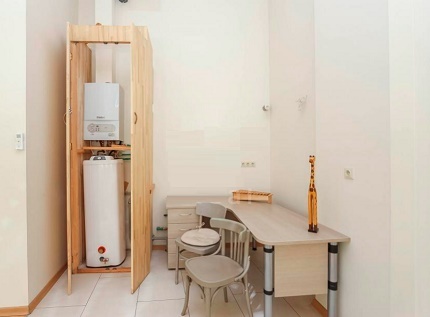
If there is no space for the construction of a partition or a ready-made niche in the kitchen, think about assembling a pencil case from chipboard with non-combustible inner lining
In addition to those listed, it must be admitted that the options are not the easiest to implement, there are methods available to most. This is gluing and painting the boiler body in compliance with the color scheme of the kitchen interior. It is possible to use the decoupage technique in the design.
What to do with communications and chimney?
Do not forget about plumbing, gas, chimneys and electrical wiring. The listed communications required for the operation of equipment for heating water or heat carrier look rather unattractive. Especially if they were built by an inexperienced and unskilled performer.

If the appearance of the water heating device suits you perfectly, but the section of the supply line with valves and taps is annoying, you can simply close it with a hard screen
For the most part, communications for the operation of gas equipment cannot be masked due to the need for regular inspection and maintenance. The easiest method is to paint with a suitable color paint or turn it into an original art object.
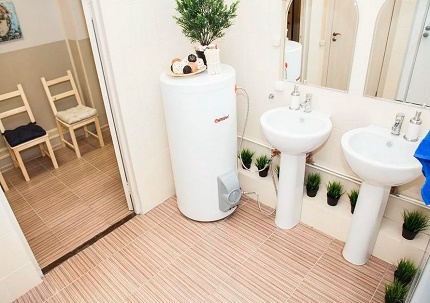
Adherents of non-standard design solutions will probably come up with their own version, but as a non-trivial design, we suggest considering the option in the photo
If the kitchen is set up in a new building "from scratch", you can think over the location of the boiler and furnishings in advance. In this case, you can make a partial change of the route of communications. And the wiring line in any case will have to be laid separately.
In the kitchen that has served the kitchen, the pipes for the supply of water and gas are decorated in a different way. Here, only boxes are applicable that provide unhindered access directly to the pipes. Access to the shut-off valves should not be a problem. The best choice for this is a blind frame.
It is permissible to hide the coaxial chimney for a boiler with a closed burner behind a stationary box. An example of assembling a two-tier box will be demonstrated by the following photo gallery:
Image gallery
Photo from
Carefully fill the passages of the coaxial chimney through the walls with foam. We install the first tier of the frame, which will cover part of the first knee. We use a metal corner or a profile for drywall
We sheathe the constructed supporting structure with plasterboard, following the generally accepted rules for attaching these sheets
We build the second tier of the frame, which will cover the bulk of the pipe. The frame around the chimney will serve as a measured basis for it.
We close the second tier of the frame with plasterboard. We process seams and installation points of fasteners with putty
Step 1: Construction of the frame for the first tier of the box
Step 2: Sheathing the structure with plasterboard
Step 3: Arrangement of the second tier of the frame
Step 4: Sewing the frame and preparing for finishing
Do not forget that even to such a reliable system as coaxial flue duct access must be guaranteed in case of replacement or repair. That is, it is necessary to leave the opportunity to disassemble the camouflage structure, if necessary. It is advisable to use materials in the decoration that you will not be sorry to part with before a complete replacement.
Conclusions and useful video on the topic
A visual demonstration of the process of masking a double-circuit boiler and pipes will help you understand the essence of the work:
The following video will introduce you to an elegant and stylish decoration option:
Using a furniture front to hide a gas boiler is a great tip for those who would like to "fit" equipment into a headset cabinet:
You can disguise the boiler located in the kitchen in any of the following ways. The main thing is not to forget about the ventilation indents and the regular supply of air for the atmospheric burner. And it is important to create conditions for safe operation of the gas apparatus for those around.
It is possible that in your arsenal there is a more interesting or simple method of camouflaging gas equipment. Share useful information in the block below. Leave comments there, ask questions, post photos on the topic of the article.


